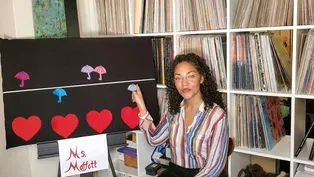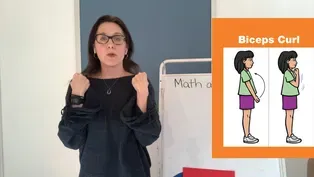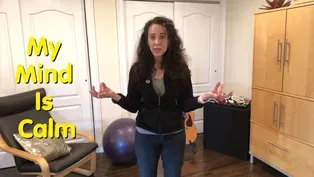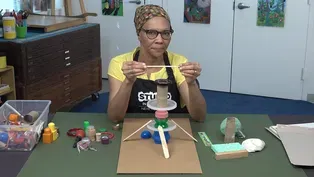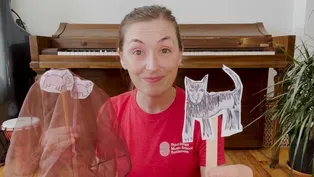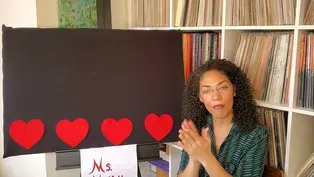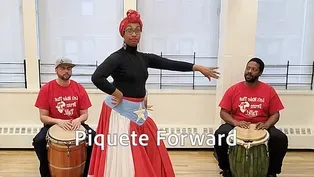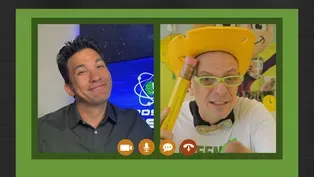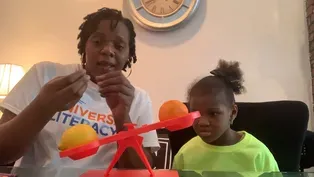
Where Starts with "wh"!
3/1/2021 | 55m 24sVideo has Closed Captions
Learn about animal shelters, create a dance map, read OVER AND UNDER THE POND.
Learn about animal shelters, create a dance map, read OVER AND UNDER THE POND, practice digraphs th & wh. LET’S LEARN helps children ages 3-8 with at-home learning. One-hour programs feature instruction by educators and virtual field trips.
Problems with Closed Captions? Closed Captioning Feedback
Problems with Closed Captions? Closed Captioning Feedback
Let's Learn is a local public television program presented by THIRTEEN PBS

Where Starts with "wh"!
3/1/2021 | 55m 24sVideo has Closed Captions
Learn about animal shelters, create a dance map, read OVER AND UNDER THE POND, practice digraphs th & wh. LET’S LEARN helps children ages 3-8 with at-home learning. One-hour programs feature instruction by educators and virtual field trips.
Problems with Closed Captions? Closed Captioning Feedback
How to Watch Let's Learn
Let's Learn is available to stream on pbs.org and the free PBS App, available on iPhone, Apple TV, Android TV, Android smartphones, Amazon Fire TV, Amazon Fire Tablet, Roku, Samsung Smart TV, and Vizio.
Providing Support for PBS.org
Learn Moreabout PBS online sponsorshipMore from This Collection
Video has Closed Captions
Read SCHOOL BUS and draw one, learn about prefixes and pitch, build sculptures. (57m 48s)
Running and Counting Both End in “ing”!
Video has Closed Captions
Move to improve, find the missing number, learn songs from Ghana, read ABUELITA’S SECRET. (58m 17s)
What Sound Does “aw” Make in Draw?
Video has Closed Captions
Read a story, discover "au" and "aw," learn about density, count, and move with music. (56m 58s)
Can You Find the Short “u” in Subtract?
Video has Closed Captions
Help Super Grover 2.0 solve a prickly problem, read ALL THE WAYS TO BE SMART. (56m 19s)
What Sound Does “gl” Make in Glove?
Video has Closed Captions
Play the glockenspiel, help Super Grover 2.0 make a cart move, read TWO WOOL GLOVES. (58m 9s)
Incredible Starts with Short “i”!
Video has Closed Captions
Solve problems with Super Grover 2.0, catch a rainbow, hear a piano sound like a cuckoo. (56m 9s)
What’s the Sound of “oo” in Book?
Video has Closed Captions
Explore animals’ form and function, sing about the 3 little pigs, read THE LITTLE BOX. (58m 15s)
We’re Reducing, Reusing and Recycling!
Video has Closed Captions
Learn all about rhythm and the number 9, read A BAG IN THE WIND. (56m 17s)
Video has Closed Captions
Learn to dance bomba and grow food in a city, read WOLF CUB’S SONG. (55m 20s)
How Many Syllables are in Invent?
Video has Closed Captions
Invent your own instrument, make 10 to add numbers to 20, read ONE GOLDEN RULE AT SCHOOL. (57m 36s)
Video has Closed Captions
Learn about the science behind mind reading, count shells, read MY BIG FAMILY. (57m 27s)
Which is Heavier: One Apple or Two Apples?
Video has Closed Captions
Defy gravity, learn secret code words for fast and slow in music, read WHOOO KNEW? (58m 5s)
Providing Support for PBS.org
Learn Moreabout PBS online sponsorship[upbeat music] - [Announcer] Ready to learn?
- Hi.
- [Announcer] It's time to share a story, - Shh.
- [Announcer] Read and write, - Let's read it back.
- [Announcer] Discover science, sing.
[humming] Play.
And so much more.
- Cupcake.
- Very good.
- [Announcer] Stay tuned for lessons and activities.
- We're gonna start making some words, isn't that fun?
[upbeat music] - [Announcer] Funding for this program was provided by the JPB Foundation.
[upbeat music] - Hi everyone, my name is Becca.
And I'm a teaching artist with the New York City Children's Theater.
I have a little secret to share with you.
I love to act and sing and dance.
Do you like to play, pretend and act silly?
I hope so.
Because today, we are going to be reading a story, and there will be different points of the story where you get to act out what happens.
Now, all you need for this is your body, your voice, and your imagination.
Actually let's take a moment to put on our imagination cap.
Mine is teal with glitter.
Another note about safety before we begin, you can do any of these exercises sitting or standing.
Just make sure before you start you look around to see if there's any furniture, or people, or pets that you might bump into.
Today, we will be reading a story called "Over and Under the Pond" by Kate Messner, with art by Christopher Silas Neal.
The story follows a young boy and his mother, as they ride over a pond in a boat.
A pond is smaller than the ocean, even smaller than a river, even smaller than a lake.
But not smaller than a puddle that you might splash in.
So the boy looks over his boat and under into the pond and sees many living things there like fish and frogs.
He looks above the pond, and sees many living things there too like birds and a moose.
As we read today, try to keep track of all of the different animals and plants that live over the pond, and all the different animals and plants that live under the pond.
All right.
Before we start, I want you to imagine that you have a rowboat, just like our friend in the story.
So grab an imaginary oar, and row on one side to the next.
You can even add a sound if you like.
Shh, shh.
pushing forward through the water.
Shh, shh.
And you can put it down because amazing, we are ready to get started.
"Over and Under the Pond".
Over the pond we slide, splashing through lily pads, sweeping through reeds.
Point to where the reeds are.
That's right.
These are the reeds.
A reed is a type of grass that grows in the water.
The water's a mirror, reflecting the sky.
Sunshine and clouds then a shadow below.
"What's down there?"
I ask.
"Under the pond?"
Mom says.
Have you ever looked underneath water and imagined what animals and plants live underneath there?
Call that what you might see.
Great answers.
Let's see what we find.
"Under the pond is a whole hidden world "of minnows and crayfish, turtles and bullfrogs.
"We're paddling over them now."
A minnow is a type of fish.
Let's make a fish face.
[grunts] Over the pond, we skim past tall rushes.
Whirligig beetles loop and twirl-skaters on a warm summer surface.
Under the pond, minnows dart through waving forces of grass, while a brook trout lurks, ready to lunge.
Imagine the minnows now, as they dart back and forth trying to get away from this lurking trout with the big teeth.
Imagine how they might feel now, you're right.
They're probably scared.
Let's make a fish face again, but let's imagine that we are them dirting from the trout.
[grunts] Great.
Shake it off.
[sighs] That made me feel very scared and nervous.
Over the pond, we lift and dip and pull past a row of painted turtles on a waterlogged tree.
Let's count.
One, two, three.
They slip off and away, splash, gurgle, sploosh!
That was really fun to say.
Do you wanna say it with me?
Here we go.
Splash, gurgle, sploosh!
One more time.
Splash, gurgle, sploosh!
They slip under the pond.
Over the pond, cattails rustle and shush in the wind.
Listen closely.
[crows] Lets say it all together.
[crows] Red-winged blackbirds race by.
One has grass for her nest.
Under the pond, a caddisfly larva builds a home of her own.
A secret shelter of pebbles and sand.
Each animal is bringing something back to their space.
Think of one item that you like to have in your space.
Call it out.
Thanks for sharing.
Over the pond, the shadows of trees lean out from the shore.
We coast under a low-hanging branch.
A moose looks up with a mouth full of water lilies.
We've interrupted his lunch.
Under the pond, beavers dive deep.
They pump with powerful tails and rise to the surface with delectable roots from the mud.
Over the pond, the wind gives us a push and stirs the light-dappled leaves on the shore.
There on a branch a new goldfinch teeters finally ready to fly.
[sighs] Under the pond, tadpoles are changing, learning to hop.
They're losing tails, growing legs and growing up.
Tadpoles are the first stages of an animal that you know that's green sometimes and makes the sound ribbit ribbit.
That's right.
A frog.
Over the pond, there at the shore, tall and silent and still a great blue heron stairs down into the deep.
It tenses.
Takes one long-legged step and strikes.
It catches a wiggling, quicksilver minnow from where it was hiding under the pond.
Wow.
So this animal actually was over the pond and under the pond.
Over the pond we drift, heads tipped up to the new sun, close your eyes and imagine feeling the hot sun on your face.
[inhales deeply] [sighs] A woodpecker clings to a teetering pine digging for ants.
Wow.
Look at how tall these trees are.
Point to where the woodpecker is.
You're right.
There's two of them.
Under the pond an otter claws for freshwater mussels.
And otter is one of my favorite animals.
They're very, very, very playful.
Under the pond, dragon fly larvae watch what swims by.
They catch minnows in monster-fast jaws.
Let's be one of the larvae and catch that minnow with our jaws.
One, two, three.
Now, if you look very closely, what's really interesting is that these two animals are part of the same.
So a larvae is the early stage of a dragonfly before it grows up.
Sort of similar to how a caterpillar grows into a butterfly.
Over the pond, shadow stretch.
Ospreys circle on quiet wings.
Raccoons and mink stalk the shoreline for supper.
Under the pond, with the flip of a tail a crayfish disappears in the dark.
Over the pond we head for home.
We glide.
Shh.
Pump.
Right up onto shore, as a far-off loon calls good night.
The sky turns from sunset to dusk to dark.
Night settles over the pond, the prowling catfish and drowsy and turtles, the scuttling crayfish and tadpoles-turned-frogs.
Waiting herons stalking raccoons.
And the hidden world under the pond.
The end.
It's time to get out of our boat now.
So grab your oars and paddle one, two, three more times, and place them next to you for the next time you go on an adventure in the water.
Wow.
We talked about so many different animals that were over and under the pond.
Can you remember some of the animals and plants that lived over the pond?
Can you remember some of the animals and plants that lived under the pond?
Which was your favorite?
I found it interesting that the animals all lived so closely together yet they all had different jobs.
Think about an animal that you know or have seen.
Let's pretend to be some of these animals by acting them out.
For this all you need is your body and your imagination like before.
I live near a public park and in the park I see a lot of raccoons.
In fact, the other day I walked by and I saw a raccoon standing with its two paws up reaching into a trash can for food.
Let's all pretend to be this raccoon by standing up reaching into the trash can and nibbling on some of those good eats.
[nibbling] Great job.
Now, I want you to think back to that animal that you know.
Maybe you've seen it at the ocean or at a park or in your neighborhood or in the forest, wherever you've seen that animal think about the shape of that animal's body.
Maybe it's a fish or a cat.
[nibbling] Whatever that shape is, think about how you can become that animal.
I'm going to do a countdown, and once I get to the end three, two, one, action, you will become that animal.
Here we go.
Three, two, one, action.
Nice job.
[claps] You can play this game wherever, maybe not at the dentist.
But the important thing about this game is that you use all of your senses the same way that our character did in the book when he and his mom looked and were very curious and saw all of the different animals above and under the pond.
So trusted adults, you can help with this too.
As you're walking, just make sure that you call out all the animals and the plants that you see wherever you may be.
Another way to continue this activity is you could act out the animals.
You could also draw the animal, or if you wanted to you could even imitate [barks] the sounds of the animal that you see.
Thank you, everyone so much for playing with me today.
I hope you had fun.
I had a lot of fun.
So I wish you all happy noticing and goodbye.
- Hi, Movers and shakers.
This is Violet.
And I'm here again with my friend, Jeremy.
And he's gonna help us sing a song.
First, I wanna shout out one of our friends, Durney, who helps us read stories sometimes.
She requested this song because she wanted us to spread some joy and positivity during these challenging times.
- Thank you, Violet.
Once again for having me come on and share a song with you about feeling good.
I have a question for you.
What do you do when you're having a bad day.
- Hmm.
I like to laugh or play games with my friends, I even like to sing and dance with them too.
- Nice.
That's so funny because I love those same things too.
I love hanging out and singing with my friends.
It always makes me so happy.
In fact, I have a song that I think you would love.
And I think most of you would know.
If you do feel free to sing along, move your hands, dance in your seat or jump up and down and dance and sing along with us.
It's called "Can't Stop the Feeling".
♪ I got this feeling inside my bones ♪ ♪ It goes electric, wavey when I turn it on ♪ ♪ And if you want it inside soul ♪ ♪ Just open up your heart let music take control ♪ ♪ I got that sunshine in my pocket ♪ ♪ Got that good soul in my feet ♪ ♪ I feel that hot blood in my body when it drops ♪ ♪ I can't take my eyes up off it ♪ ♪ Moving so phenomenally ♪ ♪ You gone like the way we rock it ♪ ♪ So don't stop ♪ ♪ And under the lights when everything goes ♪ ♪ Nowhere to hide when I'm getting you close ♪ ♪ When we move, well, you already know ♪ ♪ So just imagine ♪ ♪ Just imagine ♪ ♪ Just imagine ♪ ♪ Nothing I can see but you when you ♪ ♪ Dance, dance, dance ♪ ♪ Feeling good, good, creeping up on you ♪ ♪ So just dance, dance, dance ♪ ♪ Come on.
♪ ♪ All those things I should do to you ♪ ♪ But you dance, dance, dance ♪ ♪ And ain't nobody leaving soon ♪ ♪ So keep dancing ♪ ♪ I can't stop the feeling ♪ ♪ So just dance, dance, dance ♪ ♪ I can't stop the feeling ♪ ♪ So just dance, dance, dance, come on ♪ - Thanks everyone.
Thanks Jeremy.
Hope you all had fun dancing.
[upbeat music] - Hello friends.
I'm Miss Carissa.
And this is my daughter Liliana and she will be learning with us today.
Today, we are going to continue learning all about the consonant digraphs th and wh as well as the trigraph tch.
Today, we are going to do three things.
First, we are going to be warming up our ear muscles.
By blending sounds to say words then we are going to practice how to blend letter sounds and decode words with the diagraph ch, th, wh and the trigraph tch.
Last, we are going to practice reading and spelling a set of words with the same letters.
Today you will need to be really good listeners and try to participate by repeating out loud along with me as well as have something ready to write with and write on.
Maybe a trusted adult could go get that ready because you will need it for our last activity.
Let's get started.
For our first activity we will be blending sounds to say words.
I will say all the sounds in a word and then you will blend the sounds to say the word.
Listen to me blend first.
TH-I-S.
When I blend, TH-I-S.
I say the word this.
Now it's your turn to blend the sounds to say a word.
Ready?
- Yes - Ready?
- Okay.
- Listen to the sounds.
H-I-S.
Listen again to the sounds.
H-I-S. What is the word?
- His.
- His.
Did you say his?
Good.
Let's do some more.
I will say the sounds and you blend the sounds together to say the word.
Ready?
Listen.
B-A-T. Again.
B-A-T. What's the word?
- Bat.
- Bat.
Okay, ready?
Here's another one.
B-A-TH.
Again?
B-A-TH.
What's the word?
- Bath.
- Bath.
Great.
Here's another one.
P-EE.
Again.
P-EE.
What's the word?
- Pee.
- Pee.
Great.
Did you say that too?
Okay.
Here's the last one.
P-E-A-CH.
Listen again.
P-E-A-CH.
What's the word?
- Peach.
- Peach.
Did you get that?
Peach.
Excellent.
Ready to move a little bit.
Now you will blend the sounds to say a word and then act out the word in a movement related to the word.
Let's begin.
Listen.
B-O-A-T. Again.
B-O-A-T.
Blend the sound and say the word.
What word is it?
- Boat.
- Did you say boat?
If you did you're right.
Now, act out the word.
Act it out also.
It looks like you are rowing a boat.
Let's do some more.
TH-R-O-W.
Listen again.
TH-R-O-W. What word is it?
- Throw.
Did you say throw?
Then you're right.
Act it out.
Looks like you are throwing a ball.
Okay, here's the last one.
R-U-N.
Listen again.
R-U-N. What word is it?
- Run.
- Run?
Did you say run?
Then you're right.
Act it out.
Looks like you're running someplace.
Great job warming up those ear muscles.
Let's move on to our next activity.
Let's take a look at our sound spelling card for the diagraph th.
Thermometer.
Thermometer starts with the sound th.
and the spelling, T-H.
The spelling T-H stands for one sound.
TH can stand for the quiet unvoiced sound th, or the louder voice sound th.
As in that or there.
The next sound spelling card is for the diagraph wh.
As in whistle.
Whistle starts with the sound wh, and the spelling W-H.
The spelling W-H stands for one sound, wh.
The last sound spelling card is for the sound ch.
Here is a cheetah.
Cheetah starts with the sound ch which is represented by the spelling C-H.
There is another spelling for the sound ch, which is tch.
You will only see tch at that end of a word or syllable.
Now I will show you how to blend letter sounds and decode words with the digraphs ch, th, wh and the trigraph tch.
Watch how I blend the sounds represented by these letters to read the word.
Here, I have the diagraph th which is representing the voice sound TH-A-T.
Blend these sounds together, THA-T.
Blend all the sounds and read the word, that.
Great.
Let's try another one together.
Here I have the diagraph ch and it represents the sound ch.
Can you say the sounds with me?
CH-A-T.
Blend these sounds together.
CHA-T.
Blend all the sounds and read the word.
Chat.
Chat.
Excellent.
Okay, I have another word for us.
Here we go.
Can you say the sounds with me?
Oh, what did you notice?
There's the trigraph tch at the end.
Which represents the sound ch.
Okay.
Say the sounds with me.
B-A-TCH.
Blend these sounds.
BA.
Blend all the sounds together to read the word.
Batch.
Batch.
Excellent.
Okay, let's do another word.
Okay, here we go.
I noticed the diagraph wh here.
Which represents the sound WH-E-N. Did you say the sounds with me?
Let's do it again.
WH-E-N. Great.
Can you blend these sounds together?
WHE-N. Can you blend all the sounds to read the word?
When.
When.
Great.
I have one more word for us.
Okay.
Here I see the diagraph again, th.
But here it makes the unvoiced sound th.
Okay.
Ready to say the sounds with me.
TH-I-N.
Blend these sounds together.
THI-N.
Blend all the sounds to read the word.
Thin.
Thin.
Great work.
Now let's use all we know about blending sounds and words to help us read sets of words and in sentence.
I will point to the word and I will pause so that you could try reading it before me.
Thin, then, thick, when, this.
Great.
Which words rhyme.
If you said then and when, you are right.
What else do you notice about these words?
Yeah, they all have diagraphs.
Th, th, th, wh, th.
Great.
Okay.
Let's read these together.
Ready?
Bath, batch, path, patch.
Excellent.
Now let's read a sentence.
Go ahead try to read it before me.
Chicks hatch from eggs.
Say it one more time.
Chicks hatch from eggs.
Great job blending and decoding those words and reading that sentence.
Now let's move on to spelling words.
Our last activity.
You will now need what you brought to write with and write on.
Watch how I write and spell the word bath.
Bath.
B,b.
The first sound I hear is b.
That's the letter b. B-A.
My short vowel a. Bath.
Th.
As in thermometer.
Th.
That is how I spell the word bath.
Okay.
Now it's your turn.
Ready?
Spell the word, thin.
Say thin.
Like my pinky is thin.
Thin.
You can stretch it to hear all the sounds.
Thing.
Okay.
When you're ready, holds it up and show me or show a trusted adult or your stuffed animal.
Ready?
Go.
Did you spell it like this?
T-H-I-N.
Thin.
If you did, then you're right.
Here I have the diagraph th.
TH.
Okay.
Here's the last word.
Can you spell the word?
Such.
Repeat after me.
Such.
That is such a nice sweater.
Such.
Okay.
Can you spell it?
All right when you're ready.
Hold it up.
Did you spell it like this?
S-U-C-H.
Such.
If you did, then you're right.
Notice my diagraph ch here at the end.
Excellent work.
Okay everyone, you did such a great job today.
Blending sounds to say words, read words and spell words with the digraphs th, ch, wh and trigraph tch.
What do you think they did a good job, right?
- Mm hm.
- Mm hm.
Make sure you tell a trusted adult what you learned today and be sure to tune in tomorrow, to continue learning about blending sounds decoding and spelling words.
Have a great time learning.
Bye.
- I make it a priority to read with my little one, wanna know why?
- What do you wanna read?
[speaks in foreign language] - [Announcer] Reading to children is an important part of their development.
[upbeat music] The more kids are read to-- - You were there.
- [Announcer] The better they're able to read.
- I've still got to.
- [Announcer] Read to your youngsters and expose them to as many words as you can.
- And the doctor said?
- No more monkey jumping on the bed.
- Good job.
- [Announcer] Read in whichever language you're most comfortable reading.
[speaks in foreign language] You don't have to speak in English.
[speaks in foreign language] Encourage your kids to read in any language.
[kid laughs] [speaks in foreign language] - Would.
- Would.
- You.
- You.
- Eat.
- [Announcer] After all children who are read to when they're young are more likely to do well in school.
- That's great job, Isabella.
- Great job, Isabella.
- Wow.
[upbeat music] - Hey everyone.
Welcome to the Memphis Zoo here in Memphis, Tennessee.
My name is Max and I'm an animal interpreter here at the zoo.
For today's episode we're gonna talk specifically about shelter.
But speaking of shelter, it's getting a little cold outside so I'm gonna head inside to warm up.
Please feel free to join me.
Let's go.
[upbeat music] Now that we're nice and cozy inside, I'm gonna ask you the question for today's episode which is how do animals find shelter?
First, we have to define what shelter is.
Shelter is a place that animals can go to for protection from bad weather or to even hide from predators that may want to eat them.
Shelter is a place that animals can go to store their food, to sleep safely, stay nice and warm or a place they can raise their babies safely as well.
All of these things make shelter, a basic need for survival.
Therefore it is important that animals find a shelter that best suits their lifestyle.
But what about you at home?
What kind of shelter do you think best suits you?
[upbeat music] Now the importance of shelter is just as high for people as it is for animals.
Shelter keeps the safe and very comfortable.
Shelter offers us protection in a familiar space for many potential dangers that might be outside.
And shelter for people can look very different.
They can be a house, it can be an apartment, it can be a tent and so many other things.
But a shelter is going to look different based on each person's lifestyle.
And that's the same thing for animals.
Different animals live in different environments, in different climates, and then need something that suits their behavior in the wild.
First, we're gonna talk about animals that live close to the ground.
If you are an animal that lived on the ground where do you think you would find shelter?
Well, if you're an Iranian eyelid gecko like Amir you're gonna wanna find shelter somewhere that's easy to get to.
And somewhere that's very close to the ground.
Like maybe a tree stump or under a rock or even in a borough.
Some animals that live on the ground have to make their own shelter.
Kind of like Val the Mexican burrowing python.
Mexican burrowing pythons have a shovel like head that helps them move their bodies beneath the dirt.
And that way they can burrow underground.
If it gets too hot or cold outside.
This is the best fit for the python's lifestyle because they spend most of their lives on or underground.
This is a dig box which gives Val a nice place that she can play.
In her actual home she has plenty of loose dirt that she can dig into.
Hello there friends.
Well, that explains how animals that live close to the ground find shelter.
But what about animals that like to climb or fly, where do you think they find shelter?
[upbeat music] Some animals find shelter in tree cavities or high in the branches.
This helps to keep them safe from predators that might not be able to reach them.
It also makes it easier for them to watch for danger from a high advantage point.
Plus if you're an animal that likes to eat fruit then living in the trees is helpful because your food is already hanging from the branches.
Now think of all the birds you've seen flying around in the sky, they use trees as shelter to build nest for their babies and protect them from predators on the grounds.
The babies will stay up in those nests until they're big and strong enough to be able to take care of themselves.
[upbeat music] So far, we've talked about how animals that live in trees and on the ground find shelter.
But what about animals that are too big to climb a tree or to fit into a burrow?
How do you think they find shelter?
Well, if you're a giraffe you're gonna sometimes find shelter under a tall tree.
When you need to get some shade on a hot day but giraffe are actually on the move usually.
When they sleep, they only take short naps throughout the day, and they can take naps sitting down and sometimes standing up.
The reason they do this is so they can watch for any potential predators.
And it's easier for them to run away in a hurry if there's any potential danger.
Other large animals find shelter in whatever the natural environment provides.
When it is cold outside, they can find shelter in the cave behind some large boulders.
When it's too hot, they can find shade under trees or under a rocky cliff.
When they need to hide from a threat they can lay down in some bushes or tall grass.
When you're a larger animal it can sometimes be harder to build a shelter so it might be easier to find one in the wild that already fits your needs.
Do you have any large animals near where you live?
Where do you think they find shelter?
[upbeat music] So far, we've talked about the different ways that animals who fly and live on land find shelter.
What about animals that live in the water?
Where do you think they find shelter?
Why don't we go into the aquarium and see if we can figure it out?
Well, what about the animals that live in the water?
One might think that the water is their shelter already but even animals like fish needs somewhere to like rocks, plants or coral to avoid rough weather or predators.
Sometimes they just need somewhere to keep their eggs safe until they hatch.
And those are just a few ways that animals who walk, climb, fly, and swim find shelter.
There are many other ways that animals find shelter that we didn't talk about today.
Can you think of any types of animal shelters that I may have missed?
[upbeat music] So let's view today's lesson.
We learned that shelter is a place of comfort and protection for all animals and people.
And shelters can look different and be different depending on the individual animal and their needs.
So from the branches of the tree to beneath the sea, shelter is a basic need for survival for all animals.
Now you may be wondering if there's anything that you can do to help provide shelter for animals as well.
And as we mentioned earlier, animals love to find cover in trees, in the bushes or even grass.
So by planting seeds around your home or building a garden you can help to provide shelter for local wildlife near your home.
You can also do things like build bat boxes or bird houses to help give shelter to flying animals.
All right, my friends, well I had a great time hanging out with you and talking about all the different ways that animals find shelter.
I hope our talk today has made you think about what you can put into your own shelter to make yourself happy and healthy.
On that note I think it is time for me to go.
I hope you have a great rest of the day, and Thank you for joining us here at the Memphis Zoo.
Bye my friends.
[upbeat music] [speaks in foreign language] - What do you wanna read?
[speaks in foreign language] - I've still got to.
[speaks in foreign language] - The doctor said?
- No more monkey jumping on the bed.
- Good job.
[speaks in foreign language] - Would.
- Would.
- You.
- You.
[speaks in foreign language] - Great job, Isabella.
- Great job, Isabella.
- Wow.
[upbeat music] - Hi.
I'm Barry from the Dance Education Laboratory of the 92nd street Y.
And I want to talk to you about, I'm coming too, I'm coming forward too much.
Lemme back up a little.
Lemme go backwards here.
I wanna talk to you about making a dance and I have a thought, let me move sideways here.
So I just make some space for my thoughts here.
Now I'm thinking about something I can make a dance about with you.
I'm sure you're not a mind reader.
So you probably don't know what it is.
So you know what?
Let's warm up and then I'll lead you in the right direction.
Okay.
Here we go.
Take your fingers poke your toes.
[clicking] Poke your legs backwards up your body.
[clicking] [humming] And forward away.
[clicking] [humming] And backwards.
[clicking] [humming] And forward.
[clicking] [humming] Let's poke our legs sideway.
[clicking] [humming] And right up your arm, straight backwards up your arm.
[clicking] [humming] And away forwards.
[clicking] [humming] And backwards or forwards.
[clicking] [humming] And your shoulders?
Excuse me.
Pardon me?
Excuse me.
Pardon me?
Excuse me.
Pardon me?
Excuse me.
Pardon me?
Excuse me.
Pardon me?
What do you want?
Both your cheeks., and your head.
[clicking] And your back.
Okay.
Let's take our hands and pat our legs.
Pat your feet first.
- Prrr.
And now we're gonna pat our legs.
Move backwards up.
Up the belly and away.
And away.
And up.
And away.
And backwards and forwards.
Backwards and forwards.
And your shoulders, good job.
Good job.
Good job.
Thank you.
Thank you so much.
And your cheeks.
And your head.
Bump, bump, bump, bump, bump.
And your back.
Boom, boom, boom, boom, boom, boom.
Okay.
Wee gonna squeeze our toes them.
Okay, squeeze your legs backwards up your limbs.
Open your belly.
And move forwards.
And backwards.
And forward.
How about sideways.
[clicking] How about sideways on your belly.
[clicking] And backwards and forwards and backwards.
Your shoulders.
[quacks] [gentle music] And your other shoulder.
[gentle music] Hey, no ducks allowed in your house.
Squeeze your cheeks.
And your nose.
Honk, honk, honk.
And your head.
Mic, mic, mic, mic.
Your back.
[snorts] And then we're gonna nicely rub our legs bring them backwards and forwards and backwards and forwards and sideways.
[mumbles] Backwards and forward.
Like you're putting suntan lotion on our arm, the face and your neck and your bald spot.
Wait, you don't have a bald spot.
Oh, come on.
You gotta get one it's really the best haircut.
I think it'll look good on you.
And just get your back too.
Okay.
Now we're gonna close and shut.
Bring your knees and close tightly together then we're gonna open wide and close them fast.
And open it wide and close it fast.
And open fast.
And close it slow.
And open fast.
And close it slow maybe I'll trick you.
Boo.
Oh did I trick you?
Probably not.
Open wide one more it for a nice stretch and then we're gonna come on our hands and knees like this, for some cat and cow.
We're all gonna moo.
Look at your belly.
Say meow.
Can we say moo.
Meow.
And let's wag our tail like a good dog.
Look at that.
Look like such a happy dog.
Look at my puppies.
They're so happy.
Okay, let's put them together.
We go moo.
Meow.
Wag, wag.
Moo.
Meow.
Wag, wag.
And now let's get a little silly.
[mumbles] And then we'll go ahead coming on downwards and when we're done and say [moans].
Then come on your belly and say [hissing].
And back up [howling].
And on your belly [hissing].
Now good.
Stand up pull some balloons I would say.
Okay now we're gonna make our bodies balloons.
Take a big breath in, blow yourself up really wide and we pop up.
We come all the way down.
But we don't fall down.
Stay on your feet.
Do it again.
Take a big breath in.
[breathes deeply] And pop.
And up, up, up, up.
This time let's pop forward.
Pop.
Take a deep breathe.
Then [breathes deeply].
Let's pop backwards.
Prrr.
Up, up, up.
Let's pop sideways.
Prrr.
And big breath in.
Let's do a super silly one.
[breathes deeply] [mumbles] [laughs] Should we do one more?
Let's do one more silly one.
Come on.
Here we go.
As silly as you can make it.
[breathes deeply] [mumbles] All right.
Now let's move it all around the room.
You ready?
Here we go.
We'll start by moving forward and forward is wherever your belly's facing.
Here we go.
Let's just take a walk.
See, I can walk anywhere I go.
And it's my belly's leading.
So I'm walking forward.
Let's go backwards.
Look over your shoulder so we don't fall.
I'm just gonna walk backwards.
Come on.
Let's go.
Walking sideways.
Boom, boom, boom.
I can walk sideways this way and this way.
Let's go for some jumps.
Yeah.
Let's jump forward.
There we go.
My belly's leading me.
And then I'm gonna jump backwards.
So that means my back is like my front now.
So look over my shoulders.
So I don't bump.
Whoa.
Yeah.
And let's jump sideways.
I know it's fun sometimes I like to jump side to side.
Sideways, sideways, sideways, sideways, sideways, sideways, sideways, sideways.
Let's take a gallop.
What do you say?
Gallop forward.
There we go.
There's my belly.
Just it's like I'm riding horse.
[mumbles] Nice.
Tricky one.
Gallop backwards.
I'll make sure my back foot stays behind me the whole time.
Whoa.
Going backwards.
I know you can do it.
Yeah.
Yeah.
And sideways.
Hmm.
This one really feels good sideways.
I can make a circle on the sideways.
Wow.
And let's do hopping on one foot.
Hopping forwards, tricky.
Hopping backwards, tricky.
Hopping sideways.
Wow.
Other side.
Whoa.
And forward sometimes when you hop you go forwards and backwards and sideways all the time.
Cause you're trying to keep your balance.
How a skip.
Skipping forward has always feel so nice to me.
[sighs] Oh, let's skipping backwards.
Tricky one.
Back hop, step, hop.
Whoa.
Backwards.
Skipping.
Looking over my shoulders so I don't bump.
Let's give it sideways.
It's like, Ooh, I didn't even cross my leg.
That's a tricky way to do it.
Or you can just do it sideways and keep your legs straight, that's nice.
Maybe we should do something on a low level.
You can still high level.
How about a bear walking forwards?
Here comes to bear.
And backwards.
There goes to the bear.
And sideways.
Whoa.
I've never seen a bear go that way.
Wow.
And maybe we should do a crab one too.
Here we go.
Crab walking forward.
Whoa.
Crab walking backwards.
Looking over my shoulder.
Crab walking sideways.
Crabs tend to walk sideways, right?
Yeah.
Yeah.
All right.
Now we're ready.
I want to tell you about something special.
Do you know what a map is?
Have you ever seen a map?
A map is a drawing of the earth or part of the earth or just one small area.
A map tells us a lot of things about what's there?
What's around that area?
It can tell us about roads or rivers or buildings or mountains or lakes or forest.
It can tell us so many things about an area even if we're not there.
And it can help us figure out how to get somewhere.
Here's a really simple map that I made.
I wanna get to the playground.
There's my house over there.
Now to get to the playground.
I can look at the map and see how to get there.
And what's on the map.
Let's see.
So there's my house.
So I go forwards up that street and then there's a street I have to have to go sideways.
I have to go sideways and go by the fire station.
So they're I'm gonna go by the fire station.
Oh and backwards.
I go back down and there I go, I'm at the playground.
Now we've got our map but I have something else I wanna talk to you about.
It's kinda special.
It's the language of dance, right?
Dance, you don't have to speak any special language to communicate dance, right?
Everybody dances, no matter what language we speak.
But I'm gonna teach you a little bit of a special written language.
It's like a written secret code for the language of dance.
We call it that.
Although it's not a secret many people know it.
And it's good that you know it too.
Here we go.
I'm gonna show you just a few special symbols.
This is the symbol that means go forwards.
Right?
When you found everybody facing that direction you walk forwards.
This symbol means backwards.
Look at, to me, it looks almost like a thumb pointing down.
Like as if I had a thumb, I'm going, I'm going that way.
I'm going that way.
And this is a symbol for going sideways.
Makes sense, right?
Pointing left or right.
You could pick one or the other.
You don't have to use both of those.
Right?
So easy.
Let's see if you can read the symbols and dance them.
Are you ready?
I bet you understand my dance language you ready?
Okay.
Here we go.
Get ready.
I'm gonna hold up a symbol and I'll play some music.
I want you to dance.
Whatever the symbol tells us.
Are you ready?
Go forwards.
Go forward.
Jump forward.
Jump back.
I mean, skip forwards.
We got forwards.
Keep going... No it changed to backwards.
Can you walk backwards?
Look over your shoulder so you don't bump.
Can you march backwards?
Sideways.
Oh, go to the right.
Go to the left.
Go which way?
Sideways, sideways.
You could go a up sideways.
You could go down sideways.
Whoop.
We're going backwards again.
It's like that's some point in backwards.
Go backwards.
Different ways.
Maybe you can crawl backwards or bear walk backwards or gallop backwards.
We're going forwards again.
To me it looks like a finger pointing you.
Go forward.
Maybe you're gonna skip forward this time.
Maybe your gun run forwards.
Be careful with your inside.
Well and sideways one more time.
You can go to your right.
You can go to your left with this one.
Sideways, sideways, skip sideways, hop sideways, march sideways.
[sighs] Great job.
You are just reading a dance.
That's amazing.
Now I've done something really special to our map.
Remember our map to the playground.
I put the language of dance on the map to help us figure out how to get to the playground.
We're gonna dance this map and dance our way to the playground.
Are you ready?
Here we go.
Okay.
When I start the music, we're gonna start our dancing.
Starts with going forwards up that first street, away from the house.
Ready?
Music starts.
Go.
Okay.
Dance forward.
Walk forward.
Jump forward.
Skip forward.
Oh, we're working our way up the street and now we're at the corner.
We're gonna go sideways to get past the firehouse to go towards the playground.
Dance sideways, skip sideways, jump sideways, gallop sideways.
There's so many ways to go sideways.
Oh, we made it to the corner.
Last time.
Let's go backwards to get down to the playground.
Down the street.
Can you march backwards?
Can you skip backwards?
Jump, look over your shoulder.
You don't wanna bump.
Maybe been going a little level backwards like bear walk or crab walk.
And we're about to make the playground.
Boom.
We made to the playground.
Good job.
Now I want you to do the dance all by yourself.
But don't worry, I'll still be here, but I'm gonna put the map up on the screen to help you to remember how to do the dance.
Are you ready?
Okay.
Now get yourself in a shape of something in your neighborhood.
Okay, ready?
Here comes the music.
Go.
Dance forwards up that street first.
Skip forwards, jumped forwards, walk forwards, hop forwards.
Oh boy, we're about to make it to the corner.
Here we are.
And now we gonna past the firehouse, we're gonna go sideways.
We're making that turn.
Okay.
Gallop sideways, jump sideways.
Maybe you can bear walk sideways or roll sideways.
That would be fun down low.
Okay.
We finally made it to the corner, we got to go backwards and get to the playground.
Let's back it up.
Walk back, look over your shoulder.
So you don't bump.
Skip backwards, hop backwards, jump backwards.
We're about there.
Oh, we made it to the playground.
Freeze and your favorite shape of your favorite thing in a playground at one, two, three, freeze.
Great job.
You made a great map dance.
Well, that was really fun to do all that with you.
I mean, you learned about maps.
You move forwards, backwards and sideways.
Then you learn about the language of dance and symbols.
And then you read a map and danced it.
You realize you're always moving forwards and backwards and sideways all around all the time.
That means you're dancing throughout your life.
Well, I hope you had fun and you keep dancing all the way through your day.
Have a good one.
[upbeat music] - [Announcer] Funding for this program was provided by the JPB Foundation.
[upbeat music]
Let's Learn is a local public television program presented by THIRTEEN PBS
